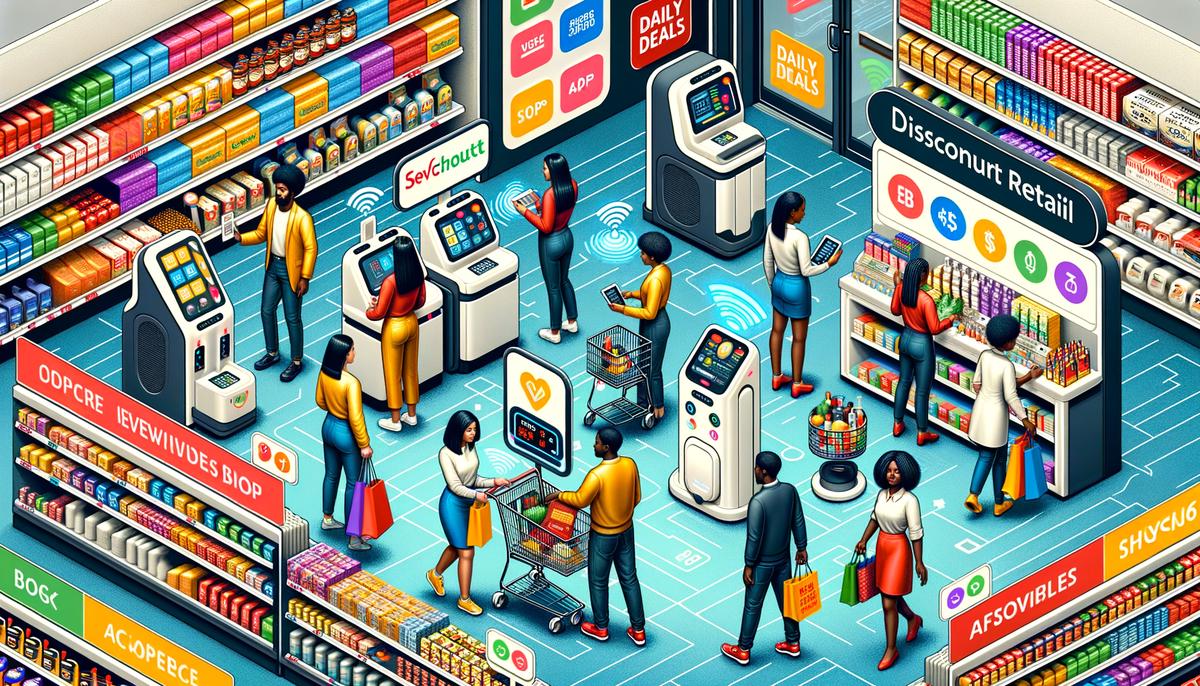The retail market today is undergoing significant transformations, influenced by economic shifts and technological advancements. This evolving landscape provides fertile ground for low-cost retail stocks, which are increasingly attracting investor attention. By focusing on how consumer behavior is changing and how businesses are adapting, we can uncover the potential for growth within this sector.
Assessment of the Retail Market Landscape
The current retail market is showing some intriguing trends, especially when it comes to low-cost retail stocks. These are shares of companies that typically offer goods at lower prices or operate on thin margins. Given the economic shifts and consumer behavior changes, there’s a growing opportunity for investors to look into these types of stocks. Here, we’ll dive into how the retail landscape is evolving and what it means for low-cost retail stock opportunities.
Economic fluctuations, including inflation and changing interest rates, are pushing consumers to become more price-conscious. This consumer shift towards seeking value for money is benefiting low-cost retailers, who are experiencing an uptick in customer traffic. Shoppers are hunting for deals, and stores that can offer quality goods at lower prices are winning their loyalty.
Furthermore, the rise of e-commerce has been a double-edged sword for the retail sector. While it has increased competition, it has also enabled low-cost retailers to expand their reach without the significant overhead costs tied to physical stores. Online platforms allow these companies to sell more, manage inventory better, and operate efficiently, ultimately supporting better margins and profitability.
Technology adoption is another factor fueling the opportunity in low-cost retail stocks. Companies investing in automation, data analytics, and innovative logistics solutions are cutting costs and improving customer experiences. These technological advancements not only help in price reduction but also ensure faster delivery times and personalized shopping experiences, enhancing customer satisfaction and loyalty.
Moreover, the trend of sustainability and ethical consumption is shaping consumer preferences. Low-cost retailers focusing on sustainable practices or offering ethically sourced products at affordable prices are standing out. This approach not only attracts environmentally conscious consumers but also helps in reducing operational costs, such as by minimizing waste.
Given these dynamics, investors are eyeing low-cost retail stocks that exhibit strong management teams, robust online strategies, technological investments, and a focus on sustainability. Companies that can navigate the challenges of thin margins while capitalizing on these consumer and industry trends are poised for growth.
The retail market is at a crossroads, where consumer demand for affordability meets digital innovation. For low-cost retailers that can adapt and innovate, the current market conditions present significant growth opportunities. As these trends continue to unfold, low-cost retail stocks are becoming an increasingly attractive proposition for investors looking to leverage the evolving retail landscape.

Financial Health and Growth Prospects of Key Players
In the realm of low-cost retail, certain companies have emerged as strong contenders for investors eyeing financial health and growth opportunities. Amidst a landscape shaped by various economic and technological shifts, these retailers have managed not just to survive but to thrive. Below, we delve deeper into identifying these promising low-cost retail stocks.
Dollar General (DG)
stands out with its impressive expansion strategy and financial performance. With over 17,000 stores across the United States, Dollar General has mastered the art of catering to underserved rural markets, where it often faces minimal competition. Financially, it has shown consistent revenue growth and robust profit margins, thanks to its diverse product mix and efficient supply chain management. Dollar General’s commitment to opening new stores and its focus on private label offerings further cement its status as a strong growth prospect.
Walmart (WMT)
, a behemoth in the retail sector, continues to exhibit solid financial health, underpinned by its massive scale and effective cost management. Walmart has adeptly navigated the e-commerce revolution, investing heavily in its online platform and delivery systems to compete with giants like Amazon. Its acquisition of Flipkart, a leading e-commerce player in India, highlights Walmart’s ambition to expand its global footprint. With a broad product range and a focus on low pricing, Walmart is well-positioned to continue its growth trajectory.
Target (TGT)
, while traditionally considered a step above “low-cost,” has efficiently introduced competitive pricing strategies that appeal to price-conscious consumers. Target has also made significant strides in enhancing its e-commerce capabilities, offering services like same-day delivery through Shipt, drive-up, and in-store pickup options. This adaptability, combined with its fashionable yet affordable private label brands, positions Target as a favorable option for investors looking at growth in the retail sector.
Five Below (FIVE)
uniquely captures the teen and pre-teen market with its dynamic product assortments, all priced at $5 or below. This clear value proposition, combined with an enjoyable in-store experience, has fostered a loyal customer base. Financially, Five Below exhibits strong sales growth and has ambitious plans to increase its store count significantly in the coming years. Its focus on new, trend-right products and seasonal merchandise keeps the shopping experience fresh and drives repeat visits.
Investing in low-cost retail stocks requires a nuanced understanding of market dynamics, consumer behavior, and operational efficiency. Retailers like Dollar General, Walmart, Target, and Five Below not only demonstrate financial stability but also hold promising growth prospects by leveraging technology, expanding their reach, and aligning with consumer demands for value and convenience. As the retail landscape evolves, these companies are well-equipped to navigate challenges and seize opportunities, making them compelling choices for investors looking to tap into the retail sector’s potential for sustainable growth.

Impact of Global Economic Factors
In the expanding universe of retail, the intersection of global economic factors with the thriving domain of low-cost retail stocks paints a fascinating picture. One cannot overlook the significant influence of geopolitical tensions and trade policies shaping the course of these stocks. The dance of tariffs, trade agreements, and international relations often plays a pivotal role in determining the cost of goods and the operational boundaries for these retailers. As countries navigate through the complexities of trade wars and negotiations, the ripple effects are palpable in the pricing strategies and supply chain decisions of stores like Dollar General, Walmart, Target, and Five Below.
Moreover, currency fluctuations emerge as a silent influencer, weaving through the financial strategies of multinational low-cost retailers. The strength or weakness of the dollar, for instance, can significantly alter the cost structure for retailers importing goods. As these companies convert their overseas earnings back to dollars, the financial outcomes can sway based on the prevailing exchange rates. This economic rollercoaster demands a sharp acumen from these retailers, forecasting and hedging against potential losses due to erratic currency movements.
Another critical economic driver is inflation rates across the globe. In periods of high inflation, consumer purchasing power diminishes, pushing more shoppers towards low-cost retail options in search of value for their money. This shift often results in a volume-driven boost for budget retailers, as they attract a broader customer base seeking relief from the price surges in essential goods and services. Conversely, in a deflationary environment, the challenge intensifies for these retailers to maintain enticing price points without eroding profit margins.
Last but not least, the global economic landscape is incompletely analyzed without considering the impact of interest rates set by central banks. These rates directly influence borrowing costs for businesses and consumers alike. For low-cost retailers, lower interest rates can mean cheaper capital for expansion projects and inventory purchases, a critical aspect of sustaining growth and competitiveness. Consumer spending also tends to rise as financing becomes more affordable, potentially driving sales up for price-sensitive retailers.
As we navigate through the intricate web of global economic factors, it’s clear that the trajectory of low-cost retail stocks is influenced by a diverse array of forces. From the tug-of-war in international trade policies to the fluctuations of the currency market, and the broader economic indicators like inflation and interest rates, each element contributes to the unfolding story of these retailers. Understanding these dynamics is key not only for investors but also for the companies themselves, as they strategize to thrive in an ever-evolving global market landscape.

Spotlight on Emerging Trends and Innovations
In the evolving landscape of low-cost retail, several emerging trends and innovations are poised to redefine the industry’s future. Among these, personalization and automation emerge as key drivers, enhancing the shopping experience while optimizing operational efficiency, a crucial factor for maintaining low prices. Moreover, the burgeoning trend of ‘retailtainment’ and the continuous evolution of supply chain management techniques promise to further shape the trajectory of low-cost retailing.
Personalization, powered by advanced data analytics and artificial intelligence (AI), allows retailers to offer tailored shopping experiences to consumers. By analyzing shopping preferences and behaviors, low-cost retailers can curate product selections, promotions, and deals that resonate with individual customers. This not only fosters customer loyalty but also maximizes the efficiency of inventory management by aligning product offerings with consumer demand.
Automation, on another front, streamlines operations and reduces labor costs—a significant expenditure for any retail operation. From automated checkout systems to AI-driven logistics and inventory management, the integration of these technologies enables low-cost retailers to maintain slim margins without compromising on service quality. Automation in customer service, including chatbots and virtual assistants, further ensures that customer inquiries and issues are addressed promptly, enhancing the overall shopping experience.
The concept of ‘retailtainment,’ combining shopping with entertainment, has gained traction, providing low-cost retailers an avenue to attract and retain customers beyond mere price considerations. By creating engaging in-store experiences, such as interactive product demonstrations, workshops, or even mini-events, retailers can enhance foot traffic and bolster sales, making the shopping experience memorable and enjoyable for consumers.
Lastly, the continuous evolution of supply chain management, accentuated by blockchain and IoT (Internet of Things) technologies, offers unprecedented levels of transparency and efficiency. These technologies facilitate real-time tracking of products, from manufacturing to delivery, ensuring the agility and responsiveness of low-cost retailers to market demands and disruptions. Moreover, they play a crucial role in authenticating the sustainability and ethical standards of products—attributes increasingly valued by today’s consumers.
In conclusion, the future of low-cost retail hinges on leveraging innovative technologies and trends to offer value, convenience, and unique shopping experiences to consumers. As the retail landscape becomes more competitive, the ability of low-cost retailers to adapt and innovate will be paramount in capturing and sustaining customer interest and loyalty.

The dynamism of the retail sector, shaped by both emerging trends and enduring consumer preferences, underscores the opportunities and challenges facing low-cost retailers. Those who harness the power of technology and innovation, while staying attuned to the needs and desires of their customers, stand to redefine success in the marketplace. As the retail world continues to change, these companies are poised not just to survive but to thrive, marking a compelling prospect for investors and indicating a significant shift in how retailing is perceived and executed.



